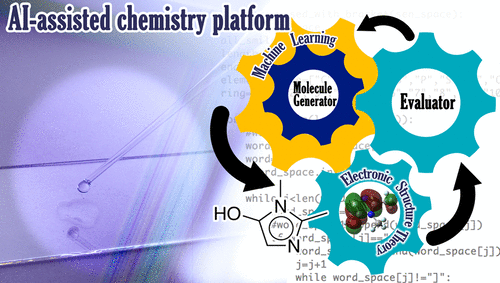当前位置:
X-MOL 学术
›
ACS Cent. Sci.
›
论文详情
Our official English website, www.x-mol.net, welcomes your feedback! (Note: you will need to create a separate account there.)
Hunting for Organic Molecules with Artificial Intelligence: Molecules Optimized for Desired Excitation Energies
ACS Central Science ( IF 18.2 ) Pub Date : 2018-08-20 00:00:00 , DOI: 10.1021/acscentsci.8b00213 Masato Sumita 1, 2 , Xiufeng Yang 1, 3 , Shinsuke Ishihara 2 , Ryo Tamura 2, 3, 4 , Koji Tsuda 1, 3, 4
ACS Central Science ( IF 18.2 ) Pub Date : 2018-08-20 00:00:00 , DOI: 10.1021/acscentsci.8b00213 Masato Sumita 1, 2 , Xiufeng Yang 1, 3 , Shinsuke Ishihara 2 , Ryo Tamura 2, 3, 4 , Koji Tsuda 1, 3, 4
Affiliation

|
This work presents a proof-of-concept study in artificial-intelligence-assisted (AI-assisted) chemistry where a machine-learning-based molecule generator is coupled with density functional theory (DFT) calculations, synthesis, and measurement. Although deep-learning-based molecule generators have shown promise, it is unclear to what extent they can be useful in real-world materials development. To assess the reliability of AI-assisted chemistry, we prepared a platform using a molecule generator and a DFT simulator, and attempted to generate novel photofunctional molecules whose lowest excited states lie at desired energetic levels. A 10 day run on the 12-core server discovered 86 potential photofunctional molecules around target lowest excitation levels, designated as 200, 300, 400, 500, and 600 nm. Among the molecules discovered, six were synthesized, and five were confirmed to reproduce DFT predictions in ultraviolet visible absorption measurements. This result shows the potential of AI-assisted chemistry to discover ready-to-synthesize novel molecules with modest computational resources.
中文翻译:

利用人工智能寻找有机分子:针对所需激发能进行优化的分子
这项工作提出了在人工智能(AI辅助)化学中的概念验证研究,其中基于机器学习的分子生成器与密度泛函理论(DFT)的计算,合成和测量相结合。尽管基于深度学习的分子生成器已显示出希望,但尚不清楚它们在实际材料开发中的有用程度。为了评估AI辅助化学的可靠性,我们使用分子生成器和DFT仿真器准备了一个平台,并试图生成新型的光功能分子,其最低激发态处于所需的能级。在这台12核服务器上运行了10天,发现在目标最低激发能级附近有86个潜在的光功能分子,分别被指定为200、300、400、500和600 nm。在发现的分子中,合成了六种,确认了五种可以在紫外可见吸收测量中再现DFT预测。该结果显示了AI辅助化学发现具有适度计算资源的易于合成的新型分子的潜力。
更新日期:2018-08-20
中文翻译:

利用人工智能寻找有机分子:针对所需激发能进行优化的分子
这项工作提出了在人工智能(AI辅助)化学中的概念验证研究,其中基于机器学习的分子生成器与密度泛函理论(DFT)的计算,合成和测量相结合。尽管基于深度学习的分子生成器已显示出希望,但尚不清楚它们在实际材料开发中的有用程度。为了评估AI辅助化学的可靠性,我们使用分子生成器和DFT仿真器准备了一个平台,并试图生成新型的光功能分子,其最低激发态处于所需的能级。在这台12核服务器上运行了10天,发现在目标最低激发能级附近有86个潜在的光功能分子,分别被指定为200、300、400、500和600 nm。在发现的分子中,合成了六种,确认了五种可以在紫外可见吸收测量中再现DFT预测。该结果显示了AI辅助化学发现具有适度计算资源的易于合成的新型分子的潜力。



























 京公网安备 11010802027423号
京公网安备 11010802027423号